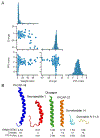Understanding Neuropeptide Transmission in the Brain by Optical Uncaging and Release
- PMID: 36719384
- PMCID: PMC10302814
- DOI: 10.1021/acschemneuro.2c00684
Understanding Neuropeptide Transmission in the Brain by Optical Uncaging and Release
Abstract
Neuropeptides are abundant and essential signaling molecules in the nervous system involved in modulating neural circuits and behavior. Neuropeptides are generally released extrasynaptically and signal via volume transmission through G-protein-coupled receptors (GPCR). Although substantive functional roles of neuropeptides have been discovered, many questions on neuropeptide transmission remain poorly understood, including the local diffusion and transmission properties in the brain extracellular space. To address this challenge, intensive efforts are required to develop advanced tools for releasing and detecting neuropeptides with high spatiotemporal resolution. Because of the rapid development of biosensors and materials science, emerging tools are beginning to provide a better understanding of neuropeptide transmission. In this perspective, we summarize the fundamental advances in understanding neuropeptide transmission over the past decade, highlight the tools for releasing neuropeptides with high spatiotemporal solution in the brain, and discuss open questions and future directions in the field.
Keywords: Brain; Light; Neuropeptide release; Neuropeptide sensor; Neuropeptide transmission.
Conflict of interest statement
Competing interests
The authors declare that they have no competing financial interests.
Figures



Similar articles
-
Neuropeptides and neuropeptide receptors: drug targets, and peptide and non-peptide ligands: a tribute to Prof. Dieter Seebach.Chem Biodivers. 2012 Nov;9(11):2367-87. doi: 10.1002/cbdv.201200288. Chem Biodivers. 2012. PMID: 23161624 Review.
-
Current and emerging methods for probing neuropeptide transmission.Curr Opin Neurobiol. 2023 Aug;81:102751. doi: 10.1016/j.conb.2023.102751. Epub 2023 Jul 22. Curr Opin Neurobiol. 2023. PMID: 37487399 Review.
-
Emerging approaches for decoding neuropeptide transmission.Trends Neurosci. 2022 Dec;45(12):899-912. doi: 10.1016/j.tins.2022.09.005. Epub 2022 Oct 15. Trends Neurosci. 2022. PMID: 36257845 Free PMC article. Review.
-
Coordinated RNA-Seq and peptidomics identify neuropeptides and G-protein coupled receptors (GPCRs) in the large pine weevil Hylobius abietis, a major forestry pest.Insect Biochem Mol Biol. 2018 Oct;101:94-107. doi: 10.1016/j.ibmb.2018.08.003. Epub 2018 Aug 27. Insect Biochem Mol Biol. 2018. PMID: 30165105
-
Bombyx neuropeptide G protein-coupled receptor A14 and A15 are two functional G protein-coupled receptors for CCHamide neuropeptides.Insect Biochem Mol Biol. 2021 Apr;131:103553. doi: 10.1016/j.ibmb.2021.103553. Epub 2021 Feb 11. Insect Biochem Mol Biol. 2021. PMID: 33582278
Cited by
-
Current Status and Future Strategies for Advancing Functional Circuit Mapping In Vivo.J Neurosci. 2023 Nov 8;43(45):7587-7598. doi: 10.1523/JNEUROSCI.1391-23.2023. J Neurosci. 2023. PMID: 37940594 Free PMC article.
-
A Biomimetic C-Terminal Extension Strategy for Photocaging Amidated Neuropeptides.J Am Chem Soc. 2023 Sep 13;145(36):19611-19621. doi: 10.1021/jacs.3c03913. Epub 2023 Aug 31. J Am Chem Soc. 2023. PMID: 37649440 Free PMC article.
-
FLP-15 functions through the GPCR NPR-3 to regulate local and global search behaviours in Caenorhabditis elegans.bioRxiv [Preprint]. 2025 May 8:2025.05.02.651881. doi: 10.1101/2025.05.02.651881. bioRxiv. 2025. PMID: 40655019 Free PMC article. Preprint.
References
-
- Katherine HT; Robin AH Volume Transmission in the Brain: Beyond the Synapse. J. Neuropsychiatry Clin. Neurosci 2014, 26 (1), iv–4. - PubMed
Publication types
MeSH terms
Substances
Grants and funding
LinkOut - more resources
Full Text Sources
Miscellaneous

